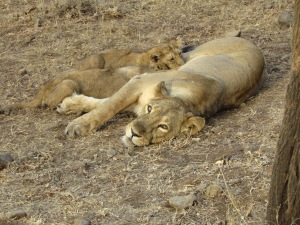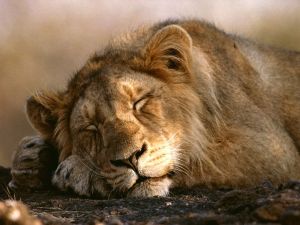Three Year Old Mother in Gir (Junagadh, Gujarat, India) has Given birth to a Record litter, all the cubs are healthy
Five seems to be the lucky number for Laxmi. This three year old lioness in Gir (Junagadh, Gujarat, India) has given birth to a litter of five. Interestingly, Laxmi herself was one of a litter of five born to lioness named Shyama.
At her age, Laxmi should usually be learning the tricks of hunting, but she is already a mother and playing the role with tremendous ease. She is taking good care of the cubs and is protecting them from all kinds of threats of jungle life.

On May 17, 2013, Laxmi gave birth to five cubs in Gir Interpretation Zone at Devaliya (Sasan Gir, Junagadh, Gujarat, India). The cubs are now 75 days old and weigh between 3.5 and 4 kg. The cubs have begun to supplement the mother’s milk with meat as they have already developed teeth. “This is a remarkable feat as normally a lioness gives birth to 2 to 3 cubs and it is rather rare for all the cubs to survive. Laxmi deserves praise for her mothering skills well proved by the thriving brood,” said a forest officer.
Gujarat’s chief wildlife warden C.N. Pandey said, “Laxmi has inherited good genes. She was born on May 3, 2010, at Sakarbaug Zoo, Junagadh (Gujarat, India) to lion Daksh and lioness Shyama. However, her mother Shyama could raise only three of them. The rest died in their infancy. Laxmi has been able to achieve a record”.
“A lioness can feed only four cubs at a time. But Laxmi has been able to work around this biological limitation.
This example illustrate that Asiatic lions are genetically strong and competent,” said Pandey. “The forest department continues to play a leading role in biodiversity conservation through dedicated management and support to nature with skill care. It is crucial that each and every individual of an endangered species is protected with proper skills and capability”.
“Birth to five cubs in a litter is extremely rare,” an official of the department said.
“We were not sure if Laxmi would be able to raise all five cubs. But she was to make a record in the known history of Asiatic Lion management. Laxmi, supported by the forest department staff, she has been able to ensure that all of her survive,” the official said.
Courtesy:- Times of India

